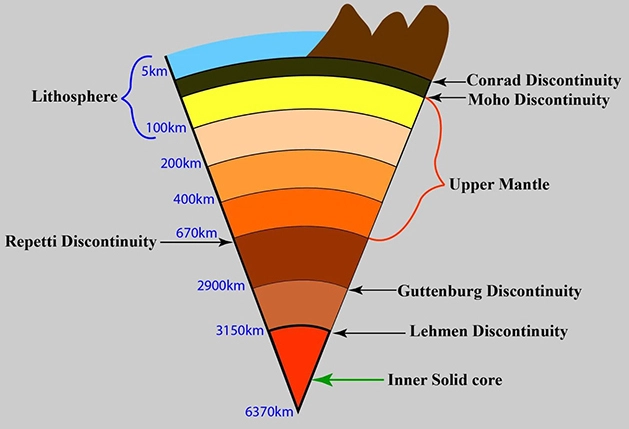Important Facts For Prelims
Hidden Mantle Layers
- 01 Mar 2023
- 3 min read
Why in News?
According to two new studies, the mantle, a layer of solid rock sandwiched between the Earth’s upper crust and lower core, has been hiding two new layers.
What are the New Studies Suggest About Hidden Mantle Layers?
- The first layer is a low viscosity zone in the upper mantle, approximately 100 kilometres thick, which was discovered by studying deep earthquakes (2018 Fiji earthquake of 8.2 magnitude) using GPS sensors.
- The second layer is a partially molten layer that extends from 90 km to 150 kilometres and sits below the tectonic plates.
- This layer was discovered by analysing seismic waves from earthquakes and suggests a higher temperature.
What is the Mantle Layer of Earth?
- About:
- The Earth's mantle is a layer of solid rock that extends from the bottom of the crust to the top of the core, with a thickness of approximately 2,900 kilometres (1,800 miles).
- The mantle is the largest layer of the Earth's interior, making up about 84% of the Earth's volume and about 68% of its mass.
- Composition:
- The mantle is composed of silicate rocks rich in iron and magnesium, and is divided into the upper mantle and the lower mantle.
- Significance:
- The mantle is an important part of the Earth's structure and plays a critical role in the geologic processes that shape the planet's surface, such as plate tectonics and volcanic activity.
- The mantle’s viscous properties govern convection — the transfer of heat between areas of different temperatures.
- The heat generated by the core is transferred through the mantle, which drives the motion of the tectonic plates on the Earth's surface.
UPSC Civil Services Examination, Previous Year Question (PYQ)
Prelims
Q. In the structure of planet Earth, below the mantle, the core is mainly made up of which one of the following? (2009)
(a) Aluminium
(b) Chromium
(c) Iron
(d) Silicon
Ans: (c)
Mains
Q. Define mantle plume and explain its role in plate tectonics. (2018)







